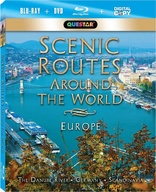
The Danube (多瑙河)
runtime 00:52:30
This is a really interesting episode which utilizes the iconic river as its focal point. Traveling over 2000 kilometers, through six countries and what the narrator terms over 25 centuries of European history, the Danube cuts a wide swath through central and eastern Europe and either passes by or actually cuts through a number of famous cities. Interestingly, the city where this piece starts, Vienna, has a man made diversion which gets the Danube into the city itself; otherwise the actual "real" river is not Viennese. In a kind of funny aside, the narrator informs us that an elderly man in a ferris wheel has told him that Josef Strauss lied, and that the Danube was never blue, and from the footage shown in this piece, that appears to be true. The river is a roiling mass of greens and browns, sometimes almost approaching a mini-rapids look as it cascades through the sylvan countryside. One poignant sidebar shows a location where scores of Jews were drowned in the Danube by the Nazis, and an art installation of sorts of nothing but empty shoes adorns the walkway abutting the river. The longest segment in this episode is devoted to Budapest, and we get to visit several places on both the Buda and Pest sides of the Danube. Gypsy violinists play for us, and we get a fine sense for how East meets West in this part of Europe. Another interesting segment discusses the 1596 Battle of Mohбcs, when Hungary fell to Turkish invaders. We then move on to a fascinating if rather morbid look inside a hospital which has been converted into a museum of sorts where plaster of paris bodies adorn various beds. One of the really cool and unexpected sights comes as a tour boat careens down the Danube, and we see a gigantic face carved into a sheer cliff face. It's a remarkable carving, kind of like Mt. Rushmore but with only one figure, of King Dace Decebal from 2000 B.C. The episode closes with a nice and aurally pleasing visit to a bird sanctuary.
Germany (德国)
runtime: 00:52:42
Though the main menu (as well as the Blu-ray cover itself) lists this episode as being about Germany, its original title of The Route of the Iron Curtain actually gives a much more accurate indication about what this episode is really about. Much like Danube charted the course of the famous river, this episode moves along that artificial yet very "real" line which split Western from Eastern Europe for decades of the Cold War. Once again we get some commentary from an unseen first person narrator, who talks about being 12 when the Berlin Wall fell and Communism joined the ash heap of history (at least in Europe), and how he used to wonder exactly what an "Iron Curtain" would look like. Once again, as in Danube, we find ourselves smack dab in Budapest, Hungary, and then begin tracing the old line of the Curtain through several countries, including the Czech Republic, what was formerly East Germany and finally what was once known as the USSR. There are some passingly funny moments in this episode, including the narrator's choice of bringing along a model of a weird, square Soviet era car with him everywhere (the lack of subtitles kept me from accurately deciphering the make and model of the car unfortunately). But there is also an overall ambience of melancholy running through much of this episode, as we see the still lingering after effects of Communism on whole communities. Entire families were rent asunder by the vagaries of the Communist bureaucracies, with various people sent off to Gulags or other prison camps for having the temerity to speak their mind. There's also a sort of sad, slovenly aspect to a lot of the back roads traveled here, roads and communities which have yet to see any real recovery from the horrors of Communism. The final moments at the Russian-Finnish border, with a group of guards warily eyeing each other, prove that though the Iron Curtain may be a thing of the past, mistrust still runs rampant in this part of the world.
Scandinavia (斯堪的纳维亚半岛)
runtime: 00:52:44
Like Germany, this episode is not actually titled Scandinavia, but instead carries the name Trans Lapland: The Road Without Night. This tour travels over 3200 kilomteters, starting in southern Finland in the seaside town of Turku, a city which virtually burnt to the ground in the early 19th century and was then rebuilt with an almost total absence of wood structures. The episode then journeys north to the "Land of the Midnight Sun" (actually the 2 a.m. sun, but I digress), before turning south again through the Swedish Alps to Sundsvall. This is a nicely scenic outing that makes the most of the incredibly gorgeous fjords in this part of the world, spending as much time on the water as it does on land. This is an episode of odd creatures and topographies, from rock formations that date to the last Ice Age to huge mutant crabs that need to be seen to be believed. Some of the most interesting footage comes from ancient Sami lands far to the north, where vestiges of that ethnicity can still be spotted in some natives. In one remote region, it's kind of funny to hear the narrator spout of statistics about the relative populations of various species. As a car traverses a road rampant with reindeer, we hear that that horned beast numbers over 280,000 while actual humans number a mere 58.000. Though this part of the country is incredibly rugged and beautiful, seemingly a haven for environmentalists, a troubling sequence details digging at the largest iron mine in the world, excavation that has become so intense that it threatens to sink an entire city which exists over various channels of the underground mines.
 淘宝店铺:http://94hd.taobao.com
淘宝店铺:http://94hd.taobao.com